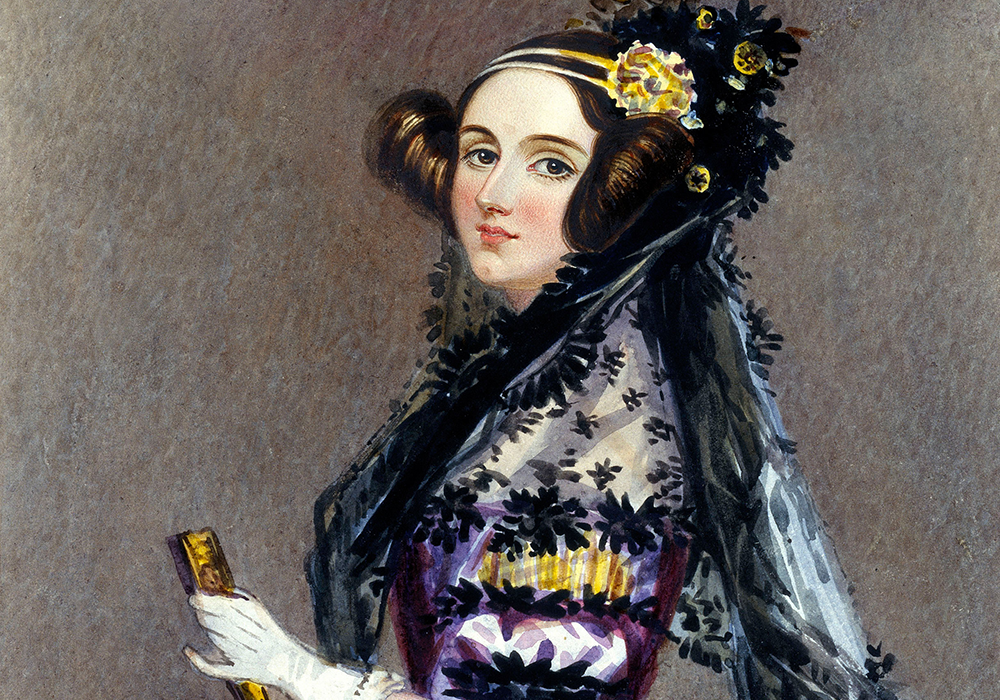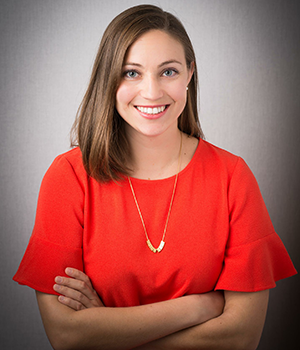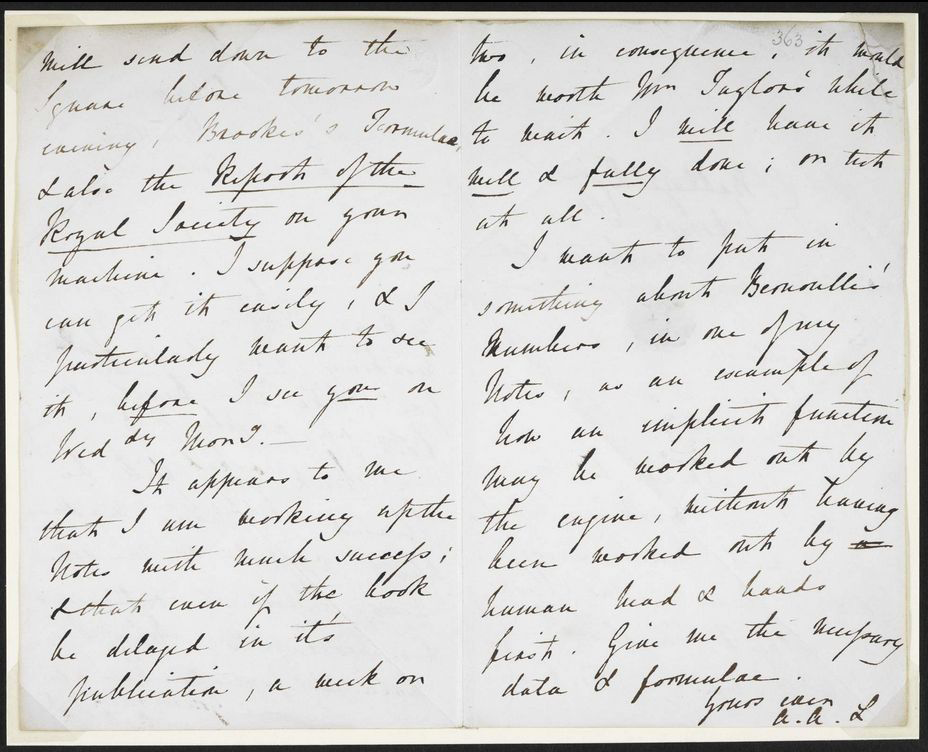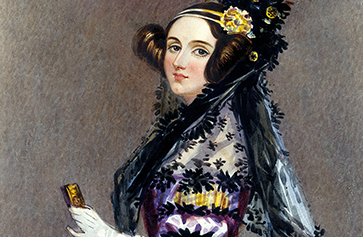A Victorian-era computer pioneer gets to speak for herself
Ada Lovelace published the first description of a computer program; a UCLA doctoral student is using AI to reveal her forgotten story

Public domain
A watercolor portrait of Ada Lovelace, believed to have been painted during the early 1840s. Work by Lovelace around that time essentially invented the form of computer algorithm that is still in use today.
Willa Reed and Alison Hewitt | March 14, 2023
It took computing historians until the late 1970s to recognize Victorian-era mathematician Ada Lovelace — once best known as the daughter of poet Lord Byron — as the world’s first computer programmer.
Now, Jessica Cook, a UCLA doctoral candidate in English, is bringing greater awareness of Lovelace into the present.
Despite Lovelace’s technical achievements and family fame, much remains unknown about her life and work, said Cook, who is writing a dissertation on the 19th-century literary history of computing. Only about 380 of Lovelace’s letters are published, while writings by Lovelace’s male colleagues have been publicly available for decades. And while more than 15,000 documents related to Lovelace’s work exist, they are viewable only at Oxford University’s Bodleian Library.
Cook is transcribing that massive archive so that Lovelace’s legacy can be broadly accessible.
“I hope that by putting all of this material out there, we can finally see the depth and breadth of Lovelace’s genius,” Cook said. “The archive is a treasure trove of handwritten documents that tantalizingly hint at a much fuller picture of Lovelace — not just as a computing pioneer, but also as an aspiring poet, neuroscientist and Christian metaphysician of creativity and free will.”
The first algorithm
In recent years, Lovelace’s discoveries have become more widely recognized and she has been celebrated as an inspiration, especially for young women in STEM fields. But many of the specifics of her work remained unknown.

Courtesy of Jessica Cook
Jessica Cook
UCLA doctoral candidate in English
“Although the Victorian scientific community had profound respect for Lovelace, many 20th-century scholars dismissed her as a naive, star-struck young woman with no advanced mathematical knowledge or insight,” Cook said. “Scholars in recent decades have been working hard to revise this one-sided view, but the difficulty of accessing her writings remains a major roadblock.”
Lovelace began working with Charles Babbage, sometimes known as the “father of the computer,” in 1833. In 1843, when she was 27, Lovelace published the first description of a computer algorithm, showing how Babbage’s proposed computing machine could function beyond a single computation to perform a programmable series of calculations. Lovelace became the first to write such a program, essentially inventing the form of computer algorithm still in use today.
Lovelace’s visionary theories addressed the potential of computing machines for not just math, but also creative work. Fittingly, Cook is using artificial intelligence to help transcribe the archive.
“She isn’t just a pioneer of computing machinery,” said Cook, who has spent more than two years deciphering Lovelace’s papers. “She’s the first person who understood theoretically that computers could be more than calculators. It was Lovelace who mused that computing machines could weave numbers together like brocade fabric and use symbolic logic to perform creative tasks like composing music.”
A legacy comes full circle
Cook visited Oxford on a grant from the UCLA Graduate Division. Once she arrived, any plans to skim through the letters quickly went out the window.
“Nineteenth-century handwriting is very hard to read,” she said. “It would have taken me years to get through it. So I made myself really focus and photographed papers for five to six hours a day for months.”
Her efforts produced roughly 15,000 photographs. But because modern handwriting transcription software doesn’t recognize the unfamiliar lettering of Victorian cursive, Cook uses an AI program that is designed to legibly replicate 18th- and 19th-century historical documents. She had to “train” the AI to recognize Lovelace’s handwriting by running tests and correcting any mistakes the program made — effectively teaching the AI to refine itself.
“I can’t help but feel that Lovelace’s legacy has come full circle as I work on this,” Cook said. “The AI tools I’m using to decode her writing are a fulfillment of the very capabilities that Lovelace’s work made possible.”

Courtesy of the British Museum
An 1843 letter from Lovelace to Charles Babbage reveals handwriting that is legible but difficult to skim.
The transcriptions reveal a woman with spates of extreme creativity, deep philosophical insights and painful health struggles. Already, Cook has detected errors and puzzling omissions in Lovelace’s few published letters. Although she is saving her biggest revelations about those discoveries for publication, Cook said some sentences mistakenly omitted single words; in other passages, key words that change the letters’ meaning were incorrectly transcribed.
In one letter, for example, Lovelace discusses the literary symbolism of a gift from her half-sister, connecting them both to Lord Byron. The published letters identify the gift as a not-particularly-literary “pin cushion,” rather than a “pen wiper,” an instrument for cleaning excess ink from a pen. The literariness of that gift, Cook said, casts the entire passage in a completely different light that until now had been lost to literary scholars who were not working directly from the original letters.
Cook anticipates that making the archive material more accessible will show the world the breadth of Lovelace’s ideas, and especially how advanced and groundbreaking her mathematical skills were.
“As someone who’s roughly the same age as Lovelace was when she was writing this material, it has been rewarding for me to see such an important female computing pioneer finally getting more of the recognition she deserves.”
This article originally appeared at UCLA Newsroom. For more news and updates from the UCLA College, visit college.ucla.edu/news.




